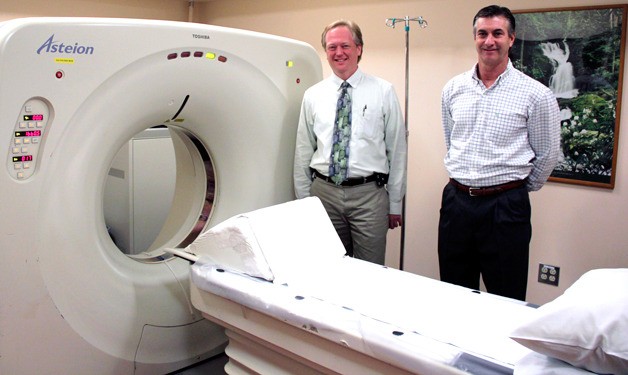Take a deep breath, and pull as much air into your lungs as you can possibly hold.
Now keep on holding.
And holding.
And holding.
Don’t breathe out yet: 30 to 40 seconds have not elapsed.
Now imagine this: You have been in a terrifying car crash. You are dizzy, disoriented and everything hurts. And doctors are asking you to hold your breath for almost a minute so that you stay completely still. They need to create an image of your body and determine the extent of your injuries using a CAT scan in order to determine how best to proceed with your treatment.
For Whidbey General Hospital trauma patients, this scenario describes the current diagnostic imaging experience involving Computer Axial Tomography.
But come December with the introduction of a brand-new, state of the art CAT scan, patient comfort and care gets a boost, something that the hospital’s Chief Radiologist Dr. Robert Hawkins and Diagnostic Imaging Manager Randy White couldn’t be happier about.
“We are thrilled,” White said. “This is excellent for the community.”
The CAT scan made by Toshiba comes with a hefty price tag of $1.3 million, but that is its only drawback, White said.
While there are models on the market that are slightly cheaper, White said, after extensive research it was determined that there are none as good.
For starters, the scan takes only 5-seconds to complete, a huge improvement for anyone subject to this machine’s scrutiny — especially someone who has sustained a trauma or is battling an illness.
And with that reduction in time comes a reduction in exposure to radiation, a decrease of about 75 percent. This is a huge deal for cancer patients, since they will frequently require multiple scans throughout their lifetime and exposure to radiation has been linked to causing this dreaded disease.
The processing time once the scan has been completed has also been reduced — letting doctors decide on the next steps in the patients treatment faster.
“Technology is always advancing,” Hawkins said. “Whidbey General will be at the cutting edge in providing diagnostic imaging.”
And this machine will allow the hospital to stay in that desirable position for as long as possible. The system allows for onsite upgrades rather than having to replace the entire machine.
More accessible
Accessibility has also improved with the new machine. The table lowers to about a foot off the ground, letting the smallest of children hop aboard with ease or wheelchair bound patients slide onto it.
And the sturdier table can handle heftier patients.
Patients needing bariatric surgery, a type of procedure to assist in weight-loss, can undergo a scan at Whidbey General, rather than having to head to a facility off-island that can handle heavier patients in the 500-plus pound range.
The new machine also has a large internal opening, which also increases patient comfort, Hawkins said.
In addition to increasing the variety of patients that the hospital can accommodate, the new machine will also allow for the hospital to expand the types of procedures that it can offer.
The placement of the new machine eliminates an awkward transfer through a public space, and increases the patient’s privacy. Patients will no longer be trundled through a waiting room.
The hospital will continue to use the old machine as the new one is brought online, a process that will take several weeks. The new CAT is expected to be operational by late December or early January.
“We upgraded the MRI. We have a new ultrasound. We are getting a new CAT scan,” White said. “The imaging department is hitting its stride.”


